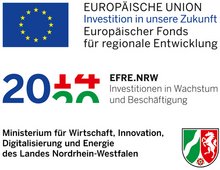In the sustainable energy system of the future, power generation will be provided by renewable energy sources, with the predominant part being provided by fluctuating energy sources such as wind and solar energy. It must therefore be expected that fluctuations in power generation will increase significantly in the future. In order to stabilise the electricity system, all conceivable balancing options will have to be used, i. e. in addition to the direct storage of electricity and improved transport through grid expansion, indirect storage (keyword: Power-to-X), but also the adaptation of electricity demand to supply.
Large-scale consumers of electricity, such as those in the energy-intensive industry, will no longer purchase electricity just according to their needs, but should, if possible, be prepared for at least partially flexible electricity purchases.
Such preparation is done for a location of the aluminium industry in Essen, where one of three aluminium electrolysis plants from TRIMET Aluminium SE will be made more flexible by retrofitting the existing plant. The performance of the plant can then be varied by approx. 25 per cent; the storage potential provided is expected to reach a volume of around 1,000 MWh (approximately the same size as a medium-sized pumped storage power plant).
The modification is supported by three chairs (automation technology/computer science; materials engineering; fluid mechanics) of the Bergische Universität Wuppertal and the Light Metals Reseach Centre of the University of Auckland. The Research Group Future Energy and Mobility Structures at the Wuppertal Institute provides the framework by the accompanying scientific research:
- How big will the actual demand for flexibility in the electricity system of the future be?
- Which of the various balancing options (grid expansion, direct and indirect storage of electricity, flexibility) is the most cost-effective at which point in time?
- How big is the flexibility potential of the energy-intensive industry as a whole and of the aluminium industry as a subset? How does this potential change under the boundary conditions of the German Energiewende (energy transition)? (keyword: decarbonisation of industry)?
- How must the framework conditions be designed so that the flexibility potential of industrial processes can actually be used?
- What possible repercussions must be taken into account for industrial processes, such as losses in efficiency?
In order to answer these and similar questions, the Wuppertal Institute's comprehensive instrumentation for modelling future energy and electricity systems will be used, or the existing models will be extended and expanded, respectively.
In addition to these energy system studies, the effects of making the energy system more flexible on important products of the energy-intensive raw materials industry will be examined. Furthermore, findings on the entrepreneurial decision on investment measures with regard to measures for realising flexibility are collected, which provide information on possible and necessary policy instruments for the management and structuring of flexibility markets. It is always taken into account that Germany as an industrial location should be preserved as such (no carbon leakage abroad), but should be based on sustainable material flows.
The project is funded by the European Regional Development Fund (EFRE) for a total of almost EUR 400,000 over a three-year period.

